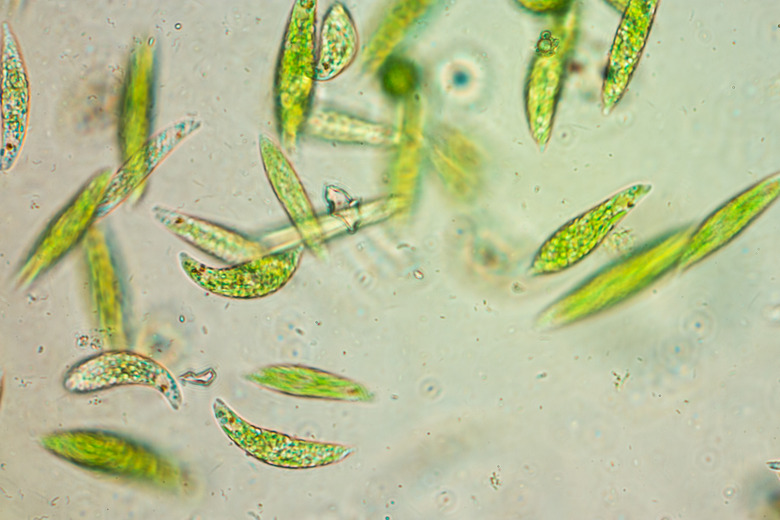What Lives In The Photic Zone?
The photic zone extends from the surface of the ocean to the depth where light is too dim for photosynthesis, on average 200 meters deep. This is similar to the epipelagic zone and sometimes the two are considered equivalent. The epipelagic is further divided into coastal, or neritic, waters located over continental shelves and oceanic waters. The photic zone is home to phytoplankton, zooplankton and nekton.
Phytoplankton
Phytoplankton
Using photosynthesis, single-celled phytoplankton take up carbon dioxide and give off oxygen. Phytoplankton are abundant in the photic zone, they perform up to 95 percent of all the photosynthesis that occurs in the ocean. Dinoflagellates, diatoms, cyanobacteria, coccolithophorids, cryptomonads and silicoflagellates are the most common phytoplankton.
Phytoplankton: Diatoms and Dinoflagellates
Phytoplankton: Diatoms and Dinoflagellates
Diatoms have silica shells, which look like microscopic sculptures. They are most common in nutrient-rich temperate zones and polar regions. Dinoflagellates, on the other hand, are much more abundant in warm, tropical waters. They have two flagella, whiplike structures that propel them through the water. When conditions are right, they can be responsible for harmful blooms, such as a red tide. A red tide can be dangerous when dinoflagellates produce toxins that are harmful to humans. These are rare, however, and any red tide that occurs near populated areas is always announced to the public.
Phytoplankton: Cyanobacteria and Coccolithophora
Phytoplankton: Cyanobacteria and Coccolithophora
Cyanobacteria are most abundant in the oceanic zone of the tropics. Since they can convert nitrogen to a usable form, called nitrogen fixation, cyanobacteria are important in nutrient-poor waters. Coccolithophora are the most abundant phytoplankton, they are found in both the neritic and oceanic zones of the epipelagic.
Phytoplankton: Cryptomonads and Silicoflagellates
Phytoplankton: Cryptomonads and Silicoflagellates
Cryptomonads are abundant in coastal waters, but have not been studied in much detail. Temperate and polar silicoflagellates form blooms like the dinoflagellates, but these are generally not harmful.
Zooplankton
Zooplankton
Zooplankton are the consumers in the photic zone. These animals are carnivorous meat eaters, herbivorous plant eaters, or omnivorous. Zooplankton range in size from single-celled protozoans to the huge comb jelly, which has been weighed at up to 5,000 lbs.
Zooplankton: Protozoa
Zooplankton: Protozoa
Protozoan zooplankton include the flagellates, ciliates, foraminiferans and radiolarians. Some protozoans also are able to photosynthesize, so are considered phytoplankton.
Zooplankton: Copepods and Other Crustaceans
Zooplankton: Copepods and Other Crustaceans
Copepods are small crustaceans found nearly everywhere in the photic zone. In fact, they might be considered the largest group of animals on the planet. Copepods are mostly herbivorous, feeding on phytoplankton. Krill are a major food source for great whales, fishes and seabirds.
Other Zooplankton
Other Zooplankton
Salps, pteropods, larvaceans, arrow worms and cnidarians are also found in the photic zone. Salps are herbivores; they filter phytoplankton with a mucus net. Pteropods are sea snails that swim using "wings," which are actually an adapted foot. Larvaceans float in a "house" of mucus, which also catches floating phytoplankton. Cnidarians, or jellyfish, are radially-symmetrical animals that come in various shapes, but usually have an umbrella and a bell. Arrow worms are zooplankton predators, feeding primarily on copepods.
Nekton
Nekton
Nekton are the largest and the most obvious animals in the photic zone, but also the least abundant. These are the fishes, marine mammals, worms, sponges, molluscs, sea stars and reptiles. While some of these large animals feed on fish, others, such as the baleen whale, feed on plankton.
References
- "Marine Biology;" Peter Castro and Michael Huber; 2003
Cite This Article
MLA
Foulds, David. "What Lives In The Photic Zone?" sciencing.com, https://www.sciencing.com/lives-photic-zone-8235174/. 22 November 2019.
APA
Foulds, David. (2019, November 22). What Lives In The Photic Zone?. sciencing.com. Retrieved from https://www.sciencing.com/lives-photic-zone-8235174/
Chicago
Foulds, David. What Lives In The Photic Zone? last modified March 24, 2022. https://www.sciencing.com/lives-photic-zone-8235174/
